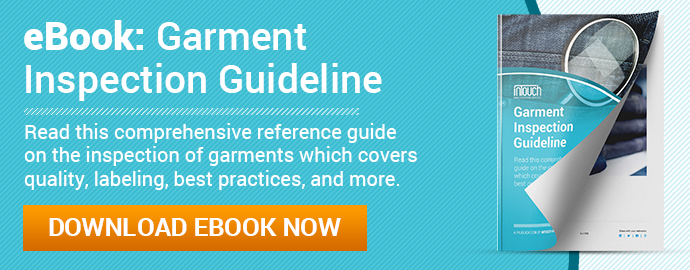 “Sorry, I just can’t stock these clothes,” explains the distribution manager of one of your customers. After asking why, he tells you that your latest order doesn’t comply with the legal requirements for clothing labeling in the destination country.
“Sorry, I just can’t stock these clothes,” explains the distribution manager of one of your customers. After asking why, he tells you that your latest order doesn’t comply with the legal requirements for clothing labeling in the destination country.
Compared to other aspects of clothing, like proper dimensions and designs, labeling may not seem like it needs special consideration. But without proper labeling, the customs authority of the country you’re exporting to might forbid you to distribute there. Labels also provide valuable information to consumers about the materials, origin, and care instructions for the clothing they buy.
While no two countries have the exact same regulations governing the labeling of clothing, the standards of the United States are a good benchmark to follow. By ensuring you meet these requirements, you’re less likely to encounter problems importing into the U.S. and elsewhere.
This article will go over some basic legal requirements for clothing labels according to the U.S. government. Let’s take a look to better understand how to ensure your garment orders reach your customers, not refused at customs.
U.S. regulations concerning clothing labeling
There are three major laws enforced by the U.S. Federal Trade Commission (FTC) and U.S. Customs and Border Protection (CPS) that govern what importers and manufacturers need to include on clothing labels:
- The Textile Fiber Products Identification Act, passed in 1960;
- The Wool Products Labeling Act, passed in 1939; and
- The Fur Products Labeling Act, passed in 1952
The second and third laws are named for the specific garment materials they cover, while the first includes a wide range of other fibers. Despite there being three different laws, labels for textile products in the U.S. must meet general requirements for textile, apparel footwear and travel goods, which include: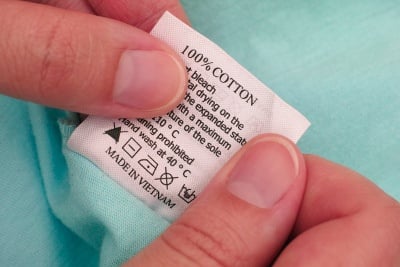
- Fiber content of the clothing;
- Country of origin;
- Manufacturer/dealer identity; and
- Care instructions
It’s important to remember that the major intent of labeling laws is to inform and protect consumers. A helpful way to work toward this goal is to put yourself in the position of uniformed end users and consider the questions they might have, such as:
- Do they avoid certain materials in garments? They may need to know the fiber content of the clothing they buy if they’re allergic to a certain material.
- Do they prefer to buy from one country versus another? “Buying American” or supporting a particular manufacturing industry may be a concern for some.
- Have they had a negative experience with one manufacturer and want to file a complaint? Knowing their concerns and actively addressing them through proper labeling will help keep your customers informed.
Textile Fiber Products Identification Act
This act covers materials aside from wool and fur. Think of it as the “umbrella” under which most clothing is regulated. It requires that clothing labels are easily visible. The labels must have a certain level of durability to survive the production and distribution process (from the factory to the consumer). For packaged goods, labels are also required on the outside of packaging, such as on hangtags or polybags.
Another important requirement is that all textile fiber products with a neck have a label located at the inside center of the neck midway between shoulder seams showing the country of origin. Fiber content and manufacturer or dealer information can also be shown on the opposing side of the same label.
Generally, products need to be labeled by the time they reach the customer. At an intermediate stage of production, like during transport from one processing facility to another, the goods only need an invoice with the fiber used, country of origin, manufacturer and the entity issuing the invoice. But if the products are nearly complete, they need proper labeling.
Wool Products Labeling Act
If your clothing contains any wool, it also falls under the jurisdiction of the Wool Products Labeling Act. Wool and recycled wool are both covered by the act. Clothing labeling requirements for products that aren’t completely made of wool but contain a portion of it overlap with the Textile Fiber Products Identification Act.
This law requires garment manufacturers to provide various information, including:
- Percentages by weight of the wool or recycled wool and other fibers that make up 5 percent or more of the product and the total of all other fibers;
- The maximum percentage in total weight of any non-fibrous matter contained in the wool product;
- The name of the manufacturer or dealer and their registered identification number (“RN”); and
- The country in which the wool product was processed or manufactured.
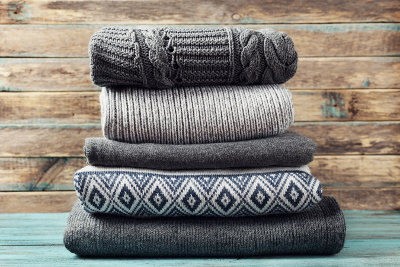 You can refer to the complete guide of compliance requirements from National Institute of Standards and Technology (NIST) for more information.
You can refer to the complete guide of compliance requirements from National Institute of Standards and Technology (NIST) for more information.
Be sure to confirm with your supplier whether there aren’t any traces of wool in your final product. Discovering this information at the last moment might mean that your clothing doesn’t comply with the Wool Products Labeling Act. And you may face civil penalties if the clothing you import doesn’t comply with a particular law.
Fur Products Labeling Act
Let’s say you sell a jacket that has nylon and wool. It also has fox fur trim around the rim of the hood. If you comply with the labeling requirements for the nylon but fail to disclose that you’re using fox fur, you’re in violation of this law. And in this case, you also need to adhere to wool labeling requirements, which further complicates what’s needed on your product.
There are many requirements to using animal fur in clothing. For a complete list, check out the summary of FTC labeling requirements for a complete list and some best practices for complying. Some of the regulations require manufactures to note:
- The animal name;
- If the fur is pointed, dyed, bleached or artificially colored;
- If the fur is used or damaged; and
- The country of origin
As with the other laws mentioned here, one of the principal reasons for labeling fur products in this way is to prevent businesses from misleading consumers. If someone wants genuine fur in their product, an appropriate label is necessary to reassure them that they’re getting what they pay for. Other consumers that prefer fake fur to real fur typically rely on proper labeling to tell the difference. Clothing labeling helps consumers make an informed buying decision.
Not all fur needs a label. Fur acquired from trapping or hunting is exempt from the Fur Products Labeling Act. Fur sold in a face-to-face transaction from a person whose main income is not fur/apparel products is also not regulated by this act. Essentially, if you’re not someone that regularly manufactures fur products or imports them, you don’t need to worry about this type of label.
Penalties for failure to meet clothing labeling regulations
Businesses that don’t comply with the provisions set forth in the laws mentioned above face monetary penalties. The FTC can issue administrative orders that prevent violations from recurring, but if these orders are disobeyed, you face a civil penalty of $16,000 per violation.
Other penalties are less severe but still cost businesses money that could be going to their bottom line instead. Violating provisions 68a, 68c, 68f, or 68g(b) in the Wool Products Labeling Act and 69a, 69d, or 69h(b) in the Fur Products Labeling Act can result in conviction of a misdemeanor, a maximum fine of $5,000 and/or up to one year in prison.
The complications don’t end there. Businesses that violate labeling laws can be subject to an injunction and consumer redress in a federal district court action. And on top of that, CPS can hold imported items at their point of entry and subject them to liquidated damages.
Identifying fiber types in garments
Using correct clothing labels might seem like a daunting task considering how many different types of materials are used in producing garments. Thankfully, the U.S. government and International Organization for Standardization (ISO) have selected common, acceptable ways to label textile products.
The Textile Fiber Products Identification Act lists generic names for manufactured fibers, which sometimes differ from those mentioned by the ISO. This is not a problem, however, because ISO names are accepted in the U.S., but they’re just not specified in the act. You can refer to ISO 2076: 2013 for more information about ISO names permitted by the FTC.
Below are several examples of acceptable ISO and generic names for manufactured fibers. Note that entries on the same line don’t indicate the same material by a different name:
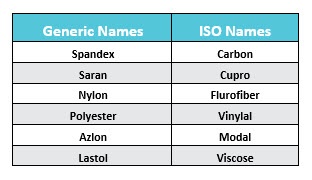
Care Labeling Rule
In addition to the laws above, the U.S. government requires businesses to inform consumers how to tend to their garments with an independent label. The Care Labeling Rule applies to textile apparel worn to cover or protect the body. Items like hats, gloves and shoes are exempt from the rule.
Who’s covered? Per FTC guidelines, the following are responsible for attaching a care label to clothing sold:
- Manufacturers and importers of textile wearing apparel;
- Manufacturers and importers of items sold to consumers for making wearing apparel; and
- Any person or organization that directs or controls the manufacturing or importing of textile wearing apparel items for making wearing apparel
If you’re covered by the Care Labeling Rule, you need to inform consumers of certain instructions and warnings. For example, a care label is required to prevent a consumer from wrongfully assuming that your product can be washed in a washing machine when it needs to be dry cleaned.
Will the material bleed if handled in a certain way? What dryer setting is best to prevent the garment from shrinking? You must provide the answers and information needed for consumers to avoid unnecessary damage to your products through normal use.
Basic garment labeling requirements by country
The laws for labeling garments in the United States provide a good point of reference. But some other countries have requirements that aren’t entirely the same. Fortunately, the U.S. Office of Textiles and Apparel (OTEXA) has created a helpful chart of labeling requirements to make sense of varying international standards. You can check out a portion of it below:
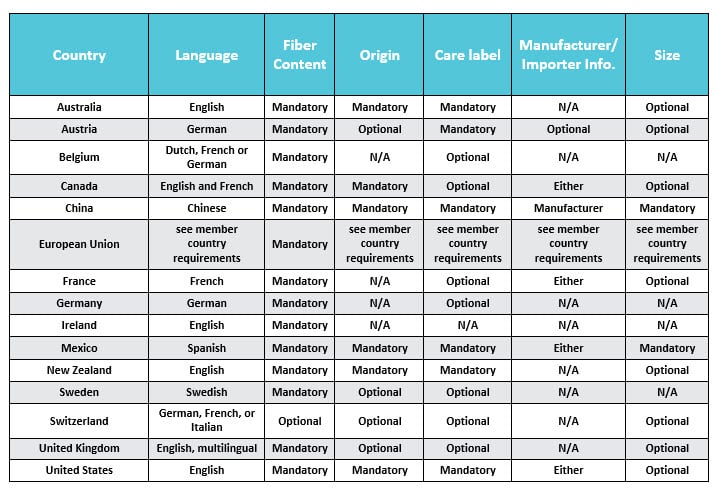
Conclusion
After you’ve spent countless hours working on stylish and unique clothing that you know will take the market by storm, the last thing you want to hear is that it can’t be sold in your target market because it’s missing a label.
It’s essential to give the process of labeling garments due consideration. Garment labels are needed not only to get through CPS and comply with FTC regulations, but they also serve as a fundamental piece of information that consumers rely on. You’d be doing your customers a disservice by omitting information that helps them make an informed buying decision and care for your product.
The next time you’re reviewing an order or conducting a garment inspection, don’t just verify that your products are free of unacceptable garment defects. Make sure that all the necessary labels are in place according to the material used in the item. After all, their salability and your bottom line depend on it.What do you find is the most challenging labeling requirement to meet for garments? Share your thoughts in the comments section below!
